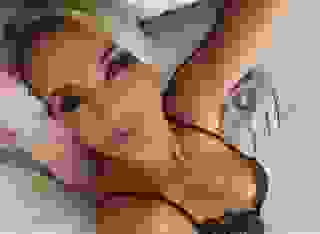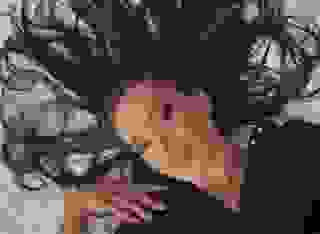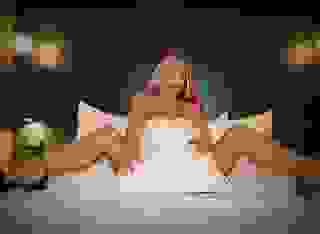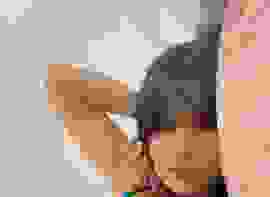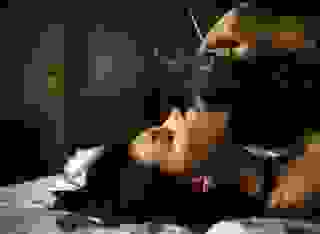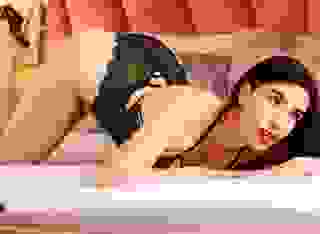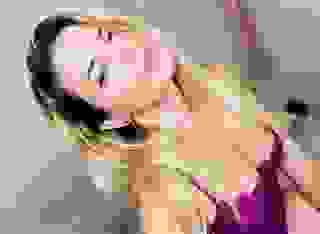Note: You can change font size, font face, and turn on dark mode by clicking the "A" icon tab in the Story Info Box.
You can temporarily switch back to a Classic Literotica® experience during our ongoing public Beta testing. Please consider leaving feedback on issues you experience or suggest improvements.
Click here"The icon on the wall before the door to the forge is the symbol of the Shinto Izanagi, or deity, who inhabits the forge." Guro< informed them. "Traditionalists that have business in the forge, will always bow their heads in prayer before the icon, asking for good fortune in the forging of the steel."
The Asoc's eyes widened briefly at the thought that the humans believed in such deities. However, Asocans, being a superstitious lot, were weary of passing beneath the icon without giving it a shallow bow and fervently wishing for good fortune in the forging of their own weapons.
The apprentice led the group into the forge. The first thing they noted was that all of the windows were shuttered, making it rather dark except for the light coming from the flames of the three forges. Tatsuya Hajime was standing beside one of the forges. He pulled out a glowing piece of metal and moved to an anvil, six apprentices standing around him with traditional Japanese hammers. These were long-handled hammers with eight kilo heads on them and that required two hands to wield.
As Hajime tapped the bright metal with his own smaller hammer, each apprentice following the tap with a blow from their much larger hammers. Hajime tapped the metal in a different place and the apprentices followed in his wake. As the guests watched, the blank was drawn out in length. They did this until the glow of the metal changed from bright yellow to a medium coloured orange.
Hajime was talking about the metal as he did this, explaining to the watching apprentices what he was doing and why and having them note the colour shifts in the metal as it cooled. "We have drawn out the metal enough. Now we have to bend it over."
Hajime had one of his senior apprentices hold a straight punch halfway up the newly drawn out piece. He hit the punch with his own hammer until he had formed a substantial line across the piece. He then struck the piece several times until he bent it backwards over on itself. Spreading flux on the metal, he placed it back into the forge and went to the next.
Hajime drew another blank that was much larger then the previous. He placed it into two supports and had two of his apprentices place straight punches over the back of it. He struck the punches with his own hammer until he had made a substantial space down the center of the back. He then placed it back into the forge and took out another blank which had been opened previously in the same manner.
"The steel being used for the blade is much harder than we need it to be. However, if we use this blade as is, it will not flex properly and will eventually break," he explained. "We need to add a piece of softer metal to the core of the blade to allow it to flex."
Hajime took another piece of glowing metal from the forge.
"Take a good look at the colour of both pieces," he said, as he placed the new piece of metal into the prepared seam. He gently hammered it into place using a straight punch until the new metal was buried as deep as he could put it. Hajime put the combined piece back into the forge and took out yet a third piece that he now placed on the anvil and directed his apprentices to hammer out into the rough shape of a >Curlat.
"Now that we have the core piece inside, we can finish the forming of the blade. This will take several passes in the forge." As he spoke, he directed with his hammer the flow of strikes from his apprentices. The >Curlat began to take shape in front of his guest's eyes. As the piece lost its bright colour, he placed it back into the second forge and went to the third.
Here, he took out a blank >Curlat that was now fully formed. "Now that the weapon has its final shape, we need to introduce the final metals to its outer surface.
"The blade must be at the correct temperature or the new metal will not bond properly with the traditional steel. If it doesn't, it will eventually flake off the surface of the new weapon.
"Note the colour of this blade. This colour tells us that the blade is too hot, which is good, as we can allow it to cool a little while we prepare the other metal." Hajime took a crucible from the forge.
"Note the colour of the liquid metal within the container," he told his students. "This metal needs to be white hot to bond properly with the steel."
He brought the crucible over to the new blade. "The colour tells me the blade is at the correct temperature. This is crucial, too cool or too hot and the new metal will not bond with it."
Hajime slowly poured the metal over the new blade. Flames and sparks gushed from the contact point, but the metal flowed correctly over the blade. Working quickly, he flipped the wide blade and did the other side.
"We must work quickly before the blade cools too much. We must ensure that we cover the blade completely with the new material. Only a thin layer is required to complete the work. Too much of the new metal and it will unbalance the blade. Too little, and it will not provide the properties that we want to the blade."
As they watched, he expertly covered the blade with the new material and placed it back into the forge.
"Now, we must monitor that blade for a significant colour shift. When we see that, we must pull the blade from the forge and allow it to cool slowly. That will complete the bonding. At any point in this process, the bonding could fail. We need to keep a wary eye on the blade until we see the colour shift.
As they watched, the blade suddenly went from bright yellow to a white colour. "That is the shift. Did you see it?" Hajime demanded of his people, who were nodding in their excitement.
"We leave it in until the entire blade becomes this colour. That will happen quickly. As soon as it has, we pull the blade from the forge." As he spoke, the blade made the final shift and Hajime pulled it from the forge and placed it on prepared blocks to cool.
"We need it to cool to a dull orange before we put it into the annealing forge for the final process. We will bring the temperature in the annealing forge up gradually and then allow the blade to cool completely over a period of twenty-four hours."
Hajime turned to his senior apprentices and told them to take over. He moved to the group of watchers.
"Asoc, it is a pleasure to finally meet you and to see you wearing the blade that I created," he said with the kind of bow that only the Japanese did.
"I too am pleased to finally meet you in person, Master Smith. I finally understand the work it took to create the blade I now wear. I see now why our blades cost so much. Such tedious work," the Asoc commented.
"This only makes the blade, Asoc. It must then be sharpened and polished." Hajime turned them around and took them into another area where apprentices were working under the eye of another master.
"Asoc, this is Watanabe Hansuke. He is the Master Sharpener for our shop," Hajime informed the group. Hansuke gave a formal bow to the Asoc and her party.
"The blades must receive a first polishing before we can begin to sharpen them," he explained to the group. "This determines if the different metals have properly bonded to each other.
"Metal sensors will only tell us how thick is the layer of material over the blade. It will not tell us definitively whether the bond is good. A polishing will show this as the metal of a poor bond will begin to flake under the pressure of the initial polishing.
"If they have properly bonded, we then begin the process of sharpening the blades, stating with course 240 grit stones and moving through six levels of coarseness to eventually end up with 1800 grit stones. It can take up to three weeks to sharpen one side of your blades."
As the Asocans watched, the apprentices slowly worked at sharpening some blades. The were using traditional long sharpening stones and water. The Asoc watched as one of the apprentices worked a new long blade over a coarse stone. She noted that the stone was laid flat on a non-slip surface with the edge of the blade hanging over the edge of the work surface as it slid along the stone. The apprentice made several passes over a small section of the blade and then moved down to the next section. She could see, now, that it would take weeks to sharpen this one-sided blade. A >Curlat had two edges. This would be tedious work.
"Do you not use machines to sharpen the blades?" one of her ministers asked.
"We could, but the machines would take too much metal too swiftly from the blade. We want to avoid that as it would weaken the edges. Machines can be programmed for mass production but this type of work requires an experienced eye," Hansuke explained.
"When the blades are finally sharpened, they will go into an electrolysis process to finish the sharpened area. This will provide additional protection to the cutting edge," Hajime told them.
He took them into another room where he showed them this process.
"Why not use this process to introduce the new metals to your blades?" the Asoc asked.
"Electrolysis normally places only a microscopic layer of material at a time on the blade. The bonded metals are much thicker than electrolysis could efficiently produce," Hajime explained.
Hajime brought them to where they were now polishing blades. They were again using traditional sharpening stones but these were smaller.
"Unlike the stones used for sharpening the blades, these sharpening stones are smaller and start at a much higher grit. We do not want to damage a blade by gouging the surface as we polish it. Eventually, our polishing will be defined by even higher grit papers and then finished with polishing cloths," Aoyama Akiara explained.
The Asoc could see the differences between the start and the end of the process. The nearly finished blades were gleaming. The Asoc had a new appreciation of the work that had gone into the finishing of her own >Curlat.
"The process of polishing can take more than a month. If it is not done right, we can restart it, however, we can only do so under limited conditions. Blades that are damaged in the sharpening or polishing stages are never sent to our customers. They are sold here at the shop as defective weapons," Hajime told them.
Hajime took them into the next room where hundreds of different kinds of bladed weapons hung on the walls. To the Asoc's trained eyes, she could instantly see the differences between the 'good' blades and those that did not make the standards. Unlike the Asocans, who used a limited number of different blades, humans seemed to have a long history of bladed weapons. The variety of blades was astonishing.
Hajime took down several blades for the Asoc to look at and handle. He had an excellent eye for the needs of those he chose for as the Asoc was able to handle the blades with ease, something she could not have done with some of the thinner or smaller blades. She very much appreciated the efforts of this human.
The Asoc selected a blade for herself and several for her previous clutches. Her current clutch was much too immature to use or even appreciate a blade at this time.
"I have to admit that when I came here, I could not believe the timelines necessary for your work. I now have a better appreciation of your efforts in creating these fine weapons.
"I have some artwork that I would like to incorporate into some of the blades now being made." The Asoc called up the items on her comp and touched it to that of Hajime's. He looked at the crests for each of the different >Curlat.
"We can incorporate the artwork in the formation stage. That will give it a permanency that laser etching would not," Hajime stated.
"Speaking of laser etching, can you add some of these details to the small blades that I have purchased to make them unique for each of the members of my clutches?" the Asoc asked.
"Yes, we can do that quite quickly and even colour the etchings, though the colouring will only last for around one hundred years. The permanent works will last for the lifetime of the blades.
Hajime noted the Asoc glancing down at her >Curlat.
"It was laser etched on Liramor-23?" he asked her. She pulled the blade and showed him both sides.
"It needs to be slightly deeper. They were probably worried that they might penetrate too deep into the outer surface of the blade. They needn't have worried. I can make this a little deeper if you want and give it a little better colourization if you show me what you want on your personal crest," he offered.
He had an apprentice bring all the blades she was going to purchase into a room behind the sales shop where several machines were in operation.
"This is Steven Marston. He codes and runs the laser etching machines," Hajime introduced a man working the machines.
"Steven, I want you to scan this >Curlat and do a deeper etching of the patterns. I also want some different colourization once you have completed the etching.
"The Asoc has purchased some blades for her family members who have distinctive crests. We will need to add that to those blades," he told the man.
Steven worked with the Asoc to set up each of the separate blades with their distinctive crests. He then scanned the Asoc's >Curlat and set it on a machine, closing the door over it to protect the eyes of the guests and workers. They watched on a monitor as the machine quickly etched the designs a bit deeper into the >Curlat taking away the colouring as it did so.
Steven then gently rubbed special colours into various parts of the crests until he was satisfied. He gave the blade to one of the apprentice polishers who took it away to the polishing section.
"I feel naked without my blade at my side," the Asoc murmured.
Immediately, Guro< drew his >Curlat and formally presented it to the Asoc.
"Until your blade is returned, Asoc," he said with a low bow. The Asoc smiled at the young Guro< and formally accepted his blade. "It will protect me until my own is returned," she replied, just as formally. She noted the inferior quality of the blade and determined that he would have one of the new ones she was having made.
"And you wish to apprentice here, Guro<?" she demanded.
"Yes, Asoc, after I have completed my apprenticeship in Asocan metallurgy in two years time," he informed her.
"I think that you will be getting a good apprentice, Hajime," the Asoc said.
"I believe that you are correct, Asoc," he replied smiling at the young Asocan.
A half-an-hour later, the Asoc's blade was returned, shining brightly once again and this time with the crests in full colour and standing out much more distinctly on the bright surface. She smiled when she saw it.
The Asoc pulled Guro<'s blade and did the first offensive form with it.
"It is a clumsy weapon, young Guro<," she stated. "Hajime, when will the first of my presentation weapons be ready?"
"I have eight blanks in the forge that will be ready for sharpening this week, Asoc," he informed her.
"Is it too late to add a crest to them?"
"No, Asoc. I can permanently place a crest on these blades before they go to sharpening. Adding the crest is the last step in the forging of the blades."
"Very well then, Hajime. This young Asocan came to my aide and offered me his weapon. That is something that most Asocans would not do, give up their personal weapon. Yet he saw my need and willingly offered me his.
"I would reward this young Guro< with one of your first blades," the Asoc stated, smiling at the surprised Guro<.
"Asoc! That is too much! I could never accept such a valuable gift for such a simple action," Guro< protested.
"Young Guro<, your action was not simple and was very much appreciated by me. I have never been without a traditional >Curlat at my side. Today, I would have been. You saw my need and answered it without hesitation, without expectations, and without being asked.
"As well, it is you who arranged for my >Curlat to be made by Hajime. Your collaboration with Tatsuya Hajime has created one of the finest >Curlats I have ever seen.
"Accept the blade you will receive, Guro<. Whether you believe it or not, your actions were noteworthy and appreciated by me.
"Hajime, you will place Guro<'s crest on the front of the blade, and my own on the back with the inscription 'Presented for a duty rendered' in the Asocan language."
A rumble began in the throats of the Asocans in the room. They lifted their snouts to the heavens and roared out their appreciation of the young Asocan's actions, ending the roar with a mighty snap as they closed their mouths.
Guro< took back his cheap blade while the Asoc looked at her own. The coloured etchings now popped against the gleaming metal. She smiled as she ran her hand over them.
"We will put a priority on your new purchases, Asoc, so that they can be returned to you before you leave at the end of the Summit," Hajime stated.
The Asoc smiled. It had been a good day, expensive, but good...
************
The Piscium family had headed in a different direction when they left The Trine. Their destination was the local shopping district, with its walking mall and many small shops. As they walked around, they noted the presence of many members of the Greater Community, all walking along the mall, enjoying the sun, looking into the windows and shopping.
The family came to their first stop, which was the music store they were looking for.
"Hello, how might I help you today?" the young woman asked as they entered the shop. Junelliya was looking around at all the instruments hanging on the walls. There was a rather large collection for such a small shop. She noted a Bandura and smiled at it.
"That is a Bandura," the woman stated helpfully.
"I am well aware of that instrument. It is similar to the Luttrell, which we use on Anuura," Junelliya informed her.
"Yes, I have heard of the Luttrell. It is made of the local hardwood?" the shopkeeper asked.
"Hardwood from Anuura tends to be stronger and lighter than Terran hardwoods, making it an excellent choice for instruments that are under a lot of stress from the number of strings they have. The Luttrell tends to be much lighter than the Bandura," Junelliya said.
"Oh, do you play?" the woman asked, noting the way Junelliya spoke on the instrument. Junelliya smiled at her.
"I have sold three of these instruments in the six years I have been in this shop, but I have never heard anyone play one." The young woman looked at her hopefully.
"Oh, Junelliya, you have done it now," Hanalei laughed. "You are going to have to play for her or she will never let you out of the shop."
The woman clapped her hands and lifted a hook to bring down the instrument, which she passed to Junelliya.
"It is indeed much heavier than the Luttrell," she commented on hefting it.
Junelliya sat on a stool in the corner and swiftly tuned the instrument. She began with the same tune that she had played the day before; a lively little festival song. Hanalei joined her voice to Junelliya's as she played. The two voices complimented each other quite well.
Junelliya then began to play an Anuuran lullaby, the soothing tones meant to help little children fall asleep. She then went into a rendition of the Pod-Drran Song Of Life singing gently of the pride of a new mother in her newborn child.
When she finished, she heard the woman catch her breath. "Oh my, that was absolutely amazing. I have never heard anyone sing or play like that."
The chime sounded as someone stepped through the open door. "Ah, I thought I heard your voice, Junelliya," Mind-Ur said as she and Kayl-Ur stepped into the shop. "The instrument sounded strange though."
"While it is similar to the Luttrell, it is not made of the same kind of wood, thus the different sounds," Junelliya advised them. She noticed the shopkeeper looking surprised to see Pod-Drran in her shop. "This is Mind-Ur of the House of Ur, and the famous Dr. Kayl-Ur, ah..."
